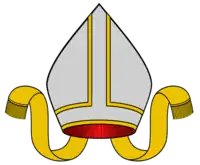Miguel de Benavides
Miguel de Benavides y Añoza, O.P. (c. 1552 – July 26, 1605) was a Spanish clergyman and sinologist who was the third Archbishop of Manila. He previously served as the first Bishop of the Diocese of Nueva Segovia, and was the founder of the University of Santo Tomas in the City of Manila.[2]
The Most Reverend Miguel de Benavides | |
|---|---|
| Archbishop of Manila | |
 | |
| Province | Manila |
| See | Manila |
| Installed | October 7, 1602 |
| Term ended | July 26, 1605 |
| Predecessor | Ignacio Santibáñez, O.F.M. |
| Successor | Diego Vázquez de Mercado |
| Other posts | Bishop of Nueva Segovia |
| Orders | |
| Ordination | 1568 |
| Personal details | |
| Born | c. 1552 Carrión de los Condes, Spain |
| Died | 26 July 1605 (aged 52–53) Manila, Captaincy General of the Philippines |
| Nationality | Spanish |
| Denomination | Roman Catholic |
| Styles of Arzobispo Miguel de Benavides | |
|---|---|
 | |
| Reference style | Monseñor |
| Spoken style | Su Excelencia Reverendísima |
| Religious style | Reverendísimo |
Biography
Miguel de Benavides was born in 1552, to a noble family in Carrión de los Condes, Spain. He entered the Dominican Order in San Pablo de la Moraleja, Valladolid, and later rendered service in Colegio de San Gregorio.
He joined the first group of Dominicans going to Manila in 1587, proceeding with them on to China where he hoped to expand the local Catholic church. He was later exiled, and established a hospital for the Chinese in Binondo, Manila, before becoming the head of his order. He accompanied Bishop Domingo de Salazar, the first bishop of Manila, to Spain to defend the native Filipinos against Spanish oppression.
Bishop
He was appointed as the first bishop of Nueva Segovia and was consecrated in Mexico in 1597. He authored the Doctrina Christiana in Chinese, one of the earliest books printed in the Philippines. He arrived in Nueva Segovia in 1599 but was, after three years, appointed as the Archbishop of Manila on October 7, 1602. His installation in Manila was financed by King Philip III himself, for Benavides was extremely poor. On September 9, 1603, he directed the Franciscans to oversee the Japanese staying in the Philippines. In the same year, he warned the government about the nascent revolt of the Chinese population although he was also criticized for inciting it with his sermons.
Death
He died on July 26, 1605 in Manila.
His library and personal property worth ₱1,500 were donated for the establishment of an institution of higher learning, now known as the University of Santo Tomas.
See also
References
- Gauchat, Patritius (Patrice) (1935). HIERARCHIA CATHOLICA MEDII ET RECENTIORIS AEVI Vol IV. Münster: Libraria Regensbergiana. pp. 261 and 230. (in Latin)
External links and additional sources
- Cheney, David M. "Archdiocese of Manila". Catholic-Hierarchy.org. Retrieved March 25, 2018. (for Chronology of Bishops) [self-published]
- Chow, Gabriel. "Metropolitan Archdiocese of Manila". GCatholic.org. Retrieved March 25, 2018. (for Chronology of Bishops) [self-published]
- Miguel de Benavides Library - University of Santo Tomas
- Roman Catholic Archdiocese of Manila - Official website
- Manila Metropolitan Cathedral - Official website
| Religious titles | ||
|---|---|---|
| New diocese | Bishop of Nueva Segovia 1595–1602 |
Succeeded by Diego Soria |
| Preceded by Ignacio Santibáñez |
Archbishop of Manila 1602–1605 |
Succeeded by Diego Vázquez de Mercado |

